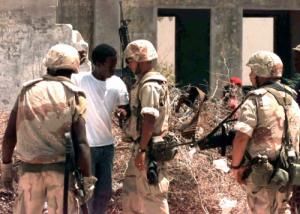|
Is Darfur
Killing Somalia? By Andrew D. Bishop (Middle East Times).
(Somalia, Sept 08,
2008 Ceegaag Online)

Every now
and then a headline will appear in our favorite newspaper
about refugees fleeing Somalia because the country's
Islamists have mounted yet another attack in their campaign
to take over Mogadishu and bring down its shaky government.
At first,
it all sounds familiar -- just another round of violence in
a part of the world where fighting has been a way of life
for decades, if not longer. But then we think: "Maybe
something really bad is going on over there; maybe we should
worry about it." Luckily, a third thought quickly comes to
mind: "No, if the situation were really troublesome, we
would have heard more about it; nothing, then, to be anxious
about." And our conscience is put to rest for the day.
The
problem is that while our conscience might be tranquil,
Somalia's people are not. In a country engaged in civil war
since the early 1990s, things have only gotten progressively
worse. The United States left Somalia in 1993 after having
experienced 18 traumatizing losses during an urban skirmish
immortalized in Mark Bowden's best-selling book, "Black Hawk
Down," later made into a Hollywood film by director Ridley
Scott
The United
Nations followed with its own withdrawal just two years
later. Since then, Somalia has been struggling for unity;
most recently both with, and against, the deployment of
Ethiopian troops in 2006 to keep the country's religious
extremists out of power.
Over the
years, this continuous course of violence has brought the
Eastern African country ever closer to complete chaos.
Jeffrey Gettleman -- one of the rare journalists to have
covered this crisis during the past years -- reported in
late 2007 that Somalia's "situation has included floods,
droughts, locusts, suicide bombers, roadside bombs and
near-daily assassinations" in addition to punctual famines
and widespread malnutrition. Yet, he wrote, "Unlike Darfur,
where the suffering is being eased by a billion-dollar aid
operation and more than 10,000 aid workers, Somalia is still
considered a no-go zone."
So why
isn't more being done to alleviate the suffering of nearly
10 million Somalis?
Unfortunately, explanations for this tragic shortfall are
plentiful. And just as with most tragedies, the chances for
a last-minute change of fate are slim.
First and
foremost, Somalia's own victimized population aside, very
few people have any interest in publicizing the country's
misery. Most prominently, the current White House has
everything to lose and nothing to gain from such a story
going public. Indeed, the George W. Bush administration's
record in Africa has been perceived by many observers as an
overall success that stands in sharp contrast to its Middle
Eastern fiascoes -- and the White House intends to protect
such a rare and favorable opinion.
Sure, it
took some time to get the Chinese on board to curb the
violence in Darfur, but Bush can point to the fact that he
eventually managed to get the job done. Likewise, while
Africa has undoubtedly continued to slip out of the West's
hands since the early 2000s, the outgoing administration can
boast the creation of the first U.S. military command solely
dedicated to monitoring the African continent -- AFRICOM.
So if
anything is certain, it is that no-one inside the current
West Wing cares to let Somalia spoil what feels like a rare
but much appreciated breeze of success.
From his
side of the world, Prime Minister Meles Zenawi of Ethiopia
certainly feels the same way. To him, Somalia's domestic
instability -- and its perfect fit into the mold of Bush's
war on terror -- has constituted an ideal opportunity to get
back at a former enemy (the two countries have fought
repeatedly since the 1960s) by indirectly taking control of
its interim government in the name of religious and civil
peace.
Neither
the current White House nor the Ethiopian executive,
however, could possibly have the power -- or, for that
matter, the true will -- to muzzle the world's organs of
free press. There must, then, be another explanation for our
blindness in the face of Somalia's distress.
This
explanation is simple: we believe only what we see.
David
Campbell -- a prominent geographer and analyst of
threat-perceptions -- has told this story before and better
than anyone. Writing about why it took the world so long to
react to the violence in Darfur, Campbell reports that "with
limited resources to assign to Africa, and a not uncommon
editorial sense that readers/viewers could handle only one
major international story at the time […] 'a curious
Catch-22' was operative: 'When it comes to mass killings of
civilians … If editors do not see it in the newspapers, they
do not believe its (sic) news. And if politicians and
officials don't see it or read it except in reports thudding
on to their desks from human rights and humanitarian NGOs,
then that doesn't quite count, either.'"
It took
years and hundreds of thousands of deaths before we realized
how extreme Darfur's misery really was. Let us now prove to
ourselves that we can monitor both Sudan and Somalia at the
same time; or else we will have no choice but to admit that
because of our dreadful failure to deal with two crises
taking place next door to each other, Darfur will be killing
Somalia for the years to come.
Andrew
D. Bishop is a freelance journalist and a regular
contributor to the Middle East Times. He blogs at
WhatYouMustRead

webmaster@ceegaag.com |

